Doom Eternal multiplayer is an experiment that bodes well for the future of shooters
It was wise to leave deathmatch behind.
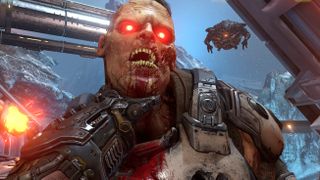
Deathmatch doesn't belong to Doom anymore. If we're honest, it hasn't for a long time. It's been decades since students drilled holes in their dorm walls to run LAN cables between their machines, desperate to participate in the bloody murder that was taking over PC gaming.
Today deathmatch is probably more closely associated with Call of Duty, and more to the point, it's evolved. Better internet connections led to the rise of voice chat and team-based modes. Games like Battlefield popularised the pursuit of map objectives, which made matches more dynamic. And after the MOBA boom, hero shooters refocused competitive shooting around the successful deployment of abilities, rather than the speed of your trigger finger. So much time has passed that, frankly, there isn't much call for standard old deathmatch—it's been appropriated and discarded by Doom's children.
Doom 2016 didn't include the mode until months after launch—and Bethesda views even that as a mistake, born of a misplaced sense of tradition. "I don't know what deathmatch has to do with Doom," Pete Hines told Shacknews. "Other than that, well, a couple of decades ago we had that, so we should just have that again."
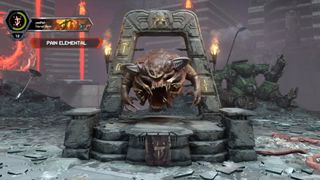
The new Doom, Eternal, features a 'Battlemode' button on its menu. Click it and you'll launch into the game's sole multiplayer offering, which pits the Doom Slayer against two human-controlled demons and their underlings. It's a smart set-up: rather than deaden the bloodthirsty highs of the campaign with an even playing field, Battlemode gives the Slayer a fresh crop of AI monsters to harvest. The demon players, meanwhile, are cast as puppeteers: controlling the flow of new monsters onto the map while watching the Slayer's outline through the terrain, waiting for the opportune moment to spring a trap.
It's unusual, to say the least, for the multiplayer component of a shooter to ask mastery of four entirely new control schemes. Most players in the weeks since launch have stuck to the Marauder—canonically part of the same legion the Slayer fought in—for his familiar shotgun and double jump. But the mode only opens up once you graduate to stranger forms. As the Pain Elemental, you drift freely through the sky as an ugly orb, occupying the spots that fall outside an FPS player's usual sightlines. From up there, it feels natural to treat the fight as a director with the occasional cameo, rather than a starring role.
The Mancubus lends himself less obviously to cunning, thanks to his enormous bodymass and booming, reverberating footsteps, but comes packing a smoke bomb. In the grey haze the Slayer can't see your outline, but you can see his, allowing you to close the distance and go to work with your flamethrower.
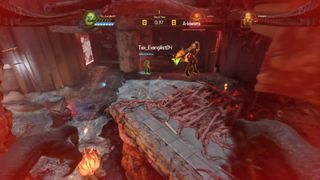
It's harder work to get to grips with the Revenant; its tendency to hover right in the middle of the Slayer's eyeline makes it juicy prey in the campaign, and the same is true for multiplayer. There's also the not-so-small matter of the jetpack, a whole new mechanic to manage while fleeing from BFG projectiles. I prefer to present a smaller target as the Archvile, watching the action from the cover of some disgusting meat orifice in a forgotten corner of the map. When the Slayer finds the Archvile, they often wish they hadn't; its fire shield can be upgraded to reflect damage, while the double whammy of a flame lake and acid attack can leave the mighty marine with as many hit points as he has social graces.
The biggest gaming news, reviews and hardware deals
Keep up to date with the most important stories and the best deals, as picked by the PC Gamer team.
While the player demons are individually weaker than the Slayer—primarily because they don't have access to the same fountain of health and armour—they can conspire to harass and confuse, and even temporarily turn off the tap of pick-ups just when the Slayer really needs them. It's a peculiar headspace to occupy, training you as a malevolent influence and leaving you feeling, well, positively demonic.
Battlemode may be too odd to stand a chance of truly taking off, and isn't helped by the superfluous intro and exit animations that add frustrating downtime to its otherwise brisk matches. But it's a strong sign that triple-A has finally left behind the mindset that saw so many solo adventures lumbered with generic multiplayer sideshows in the 2000s and 2010s.
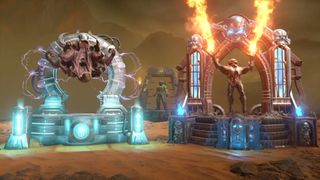
Back then, the games industry was alarmed by the growing scale of the pre-owned market. Brick-and-mortar retailers, left hurting by digital marketplaces like Steam, had begun to fill their shelves with second-hand discs. This helped the shops, but reduced overall profits for publishers and developers.
One solution, publishers decided, was to incentivise long-term play. If the discs were still whirring away in consoles, they couldn't be sold on, and the problem would go away. The model was Call of Duty: the flagship campaigns might only keep players occupied for five thrilling hours, but the multiplayer would hook them for months.
A slew of unlikely multiplayer modes came about as a consequence. Dead Space 2. Spec Ops: The Line. Bioshock, then the model for blockbuster solo gaming, sent players back into Rapture to duke it out in environments first built to explore the folly of idealism. Developers can only have been dismayed with the results—step into the lobbies of any of these modes and your footsteps will echo, so few are their players. That's if you can enter them at all: many have long since been shut down by their owners.
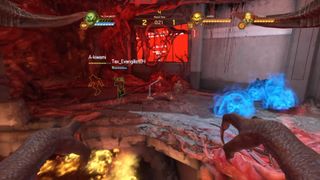
Today, the publishers have worked it out. Story campaigns can be folded into the structure of online service games as updates. Doom: Eternal leads with a meaty single-player mode that easily tops 20 hours, and longevity is provided by endgame Slayer Gate battles and weekly challenges. That eases the pressure on multiplayer, which is free to be a site of experimentation. That's a wonderful thing: experimentation leads to strange discoveries, and sometimes whole new genres.
At least, that's how I think I ended up circling an arena as a disembodied pair of claws, looking to ruin Doomguy's day.
Most Popular

